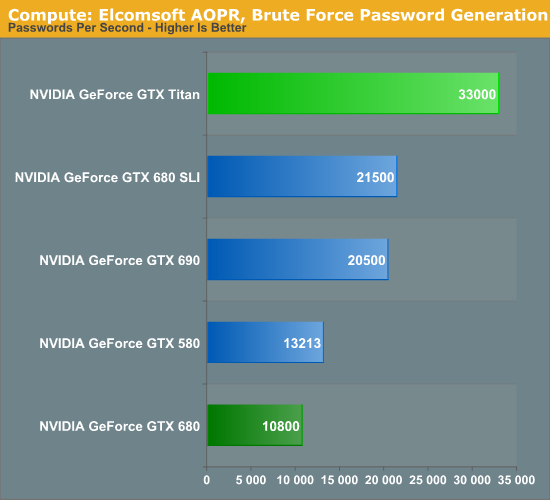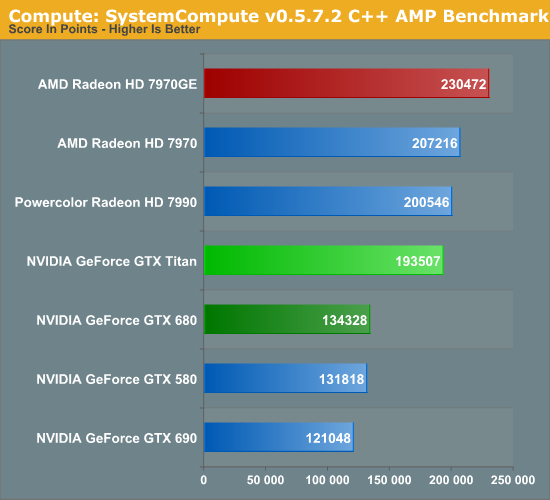NVIDIA’s GeForce GTX Titan Review, Part 2: Titan's Performance Unveiled
by Ryan Smith & Rahul Garg on February 21, 2013 9:00 AM ESTTitan’s Compute Performance, Cont
With Rahul having covered the basis of Titan’s strong compute performance, let’s shift gears a bit and take a look at real world usage.
On top of Rahul’s work with Titan, as part of our 2013 GPU benchmark suite we put together a larger number of compute benchmarks to try to cover real world usage, including the old standards of gaming usage (Civilization V) and ray tracing (LuxMark), along with several new tests. Unfortunately that got cut short when we discovered that OpenCL support is currently broken in the press drivers, which prevents us from using several of our tests. We still have our CUDA and DirectCompute benchmarks to look at, but a full look at Titan’s compute performance on our 2013 GPU benchmark suite will have to wait for another day.
For their part, NVIDIA of course already has OpenCL working on GK110 with Tesla. The issue is that somewhere between that and bringing up GK110 for Titan by integrating it into NVIDIA’s mainline GeForce drivers – specifically the new R314 branch – OpenCL support was broken. As a result we expect this will be fixed in short order, but it’s not something NVIDIA checked for ahead of the press launch of Titan, and it’s not something they could fix in time for today’s article.
Unfortunately this means that comparisons with Tahiti will be few and far between for now. Most significant cross-platform compute programs are OpenCL based rather than DirectCompute, so short of games and a couple other cases such as Ian’s C++ AMP benchmark, we don’t have too many cross-platform benchmarks to look at. With that out of the way, let’s dive into our condensed collection of compute benchmarks.
We’ll once more start with our DirectCompute game example, Civilization V, which uses DirectCompute to decompress textures on the fly. Civ V includes a sub-benchmark that exclusively tests the speed of their texture decompression algorithm by repeatedly decompressing the textures required for one of the game’s leader scenes. While DirectCompute is used in many games, this is one of the only games with a benchmark that can isolate the use of DirectCompute and its resulting performance.
Note that for 2013 we have changed the benchmark a bit, moving from using a single leader to using all of the leaders. As a result the reported numbers are higher, but they’re also not going to be comparable with this benchmark’s use from our 2012 datasets.

With Civilization V having launched in 2010, graphics cards have become significantly more powerful since then, far outpacing growth in the CPUs that feed them. As a result we’ve rather quickly drifted from being GPU bottlenecked to being CPU bottlenecked, as we see both in our Civ V game benchmarks and our DirectCompute benchmarks. For high-end GPUs the performance difference is rather minor; the gap between GTX 680 and Titan for example is 45fps, or just less than 10%. Still, it’s at least enough to get Titan past the 7970GE in this case.
Our second test is one of our new tests, utilizing Elcomsoft’s Advanced Office Password Recovery utility to take a look at GPU password generation. AOPR has separate CUDA and OpenCL kernels for NVIDIA and AMD cards respectively, which means it doesn’t follow the same code path on all GPUs but it is using an optimal path for each GPU it can handle. Unfortunately we’re having trouble getting it to recognize AMD 7900 series cards in this build, so we only have CUDA cards for the time being.

Password generation and other forms of brute force crypto is an area where the GTX 680 is particularly weak, thanks to the various compute aspects that have been stripped out in the name of efficiency. As a result it ends up below even the GTX 580 in these benchmarks, never mind AMD’s GCN cards. But with Titan/GK110 offering NVIDIA’s full compute performance, it rips through this task. In fact it more than doubles performance from both the GTX 680 and the GTX 580, indicating that the huge performance gains we’re seeing are coming from not just the additional function units, but from architectural optimizations and new instructions that improve overall efficiency and reduce the number of cycles needed to complete work on a password.
Altogether at 33K passwords/second Titan is not just faster than GTX 680, but it’s faster than GTX 690 and GTX 680 SLI, making this a test where one big GPU (and its full compute performance) is better than two smaller GPUs. It will be interesting to see where the 7970 GHz Edition and other Tahiti cards place in this test once we can get them up and running.
Our final test in our abbreviated compute benchmark suite is our very own Dr. Ian Cutress’s SystemCompute benchmark, which is a collection of several different fundamental compute algorithms. Rahul went into greater detail on this back in his look at Titan’s compute performance, but I wanted to go over it again quickly with the full lineup of cards we’ve tested.

Surprisingly, for all of its performance gains relative to GTX 680, Titan still falls notably behind the 7970GE here. Given Titan’s theoretical performance and the fundamental nature of this test we would have expected it to do better. But without additional cross-platform tests it’s hard to say whether this is something where AMD’s GCN architecture continues to shine over Kepler, or if perhaps it’s a weakness in NVIDIA’s current DirectCompute implementation for GK110. Time will tell on this one, but in the meantime this is the first solid sign that Tahiti may be more of a match for GK110 than it’s typically given credit for.










337 Comments
View All Comments
CeriseCogburn - Saturday, February 23, 2013 - link
Stop whining along with the rest of them, grow a set, get a job, and buy two of them.Might do you some good.
Alucard291 - Sunday, February 24, 2013 - link
Unlike you, I have a job :)chizow - Sunday, February 24, 2013 - link
Good point, I'd tend to agree with that assessment as anyone who actually works for their money would not be so eager to part with it so quickly in $1K denominations for what amounts to a glorified pinball machine.He's probably a kid who has never had to work a day in his life or a basement dweller who has no hope of ever buying one of these anyways.
CeriseCogburn - Sunday, February 24, 2013 - link
And now with the pure troll, the lying idiot conspiracist nVidia hater takes on the pure personal attack for a big fat ZERO score.Congratulations, you and your pure troll can high five each other and both be wrong anyway, for another yer or two, or the rest of your whining crybaby posting PC herd idiot mentality lives.
Alucard291 - Friday, March 8, 2013 - link
No no kid. You're the "pure troll here"So yeah go get a job and buy two of them. For yourself. Stop being angry at us for not being able to afford it
~lol~
wiyosaya - Thursday, February 21, 2013 - link
While I understand your frustrations, IMHO, this is a card aimed at those wanting the compute performance of a Tesla at 1/3 the cost. As I see it, nVidia shot themselves in the foot for compute performance with the 680, and as such, I bet that 680 sales were less than expected primarily because of its crappy compute performance in comparison to say even a 580. This may have been their strategy, though, as they might have expected $3,500 Teslas to fly off the shelf.I am also willing to bet that Teslas did not fly off the shelf, and that in order to maintain good sales, they have basically dropped the price of the first GK110s to something that is reasonable with this card. Once can now buy 3.5 Titan's for the price of the entry level GK110 Tesla, and I highly expect nVidia to make a profit rather than the killing that they might have thought possible on the GK110 Teslas.
That said, I bet that nVidia gets a sht load of orders for this card from new HPC builders and serious CAD/CAE workstation suppliers. Many CAD/CAE software packages like SolidWorks and Maple support GPGPUs in their code making this card a bargain for their builds.
My apologies, to all the gamers here but us compute nerds are drooling over this card. I only wish I could afford one to put in my i7-3820 build from July. It is more than 2x what I paid for a 580 back then, and the 580 buy was for its compute performance.
atlr - Thursday, February 21, 2013 - link
wiyosaya, I am trying to come up to speed on comparing compute performance between Nvidia and AMD options. Is the Titan drool-worthy only for software that only uses CUDA and not OpenCL? This reminds me of the days of Glide versus OpenGL APIs.trajan2448 - Friday, February 22, 2013 - link
AMDs fps numbers are overstated. They figured out a trick to make runt frames, or frames which are not actually rendered to trigger the fps monitor as a real fully rendered frame. This is real problem for AMD much worse than the latency problem. Crossfire is a disaster which is why numerous reviewers including Tech Report have written that Crossfire produces higher fps but feels less smooth than Nvidia.Check this article out. http://www.pcper.com/reviews/Graphics-Cards/NVIDIA...
chizow - Saturday, February 23, 2013 - link
That's an awesome analysis by PCPer, thanks for linking that. Might end up being the biggest driver cheat scandal in history. Runt framesgate lol.CeriseCogburn - Saturday, February 23, 2013 - link
HUGE amd cheat.It's their standard operating procedure.
The fanboys will tape their mouths, gouge out their eyes and stick fingers in their ears and chant: "I'm not listening".